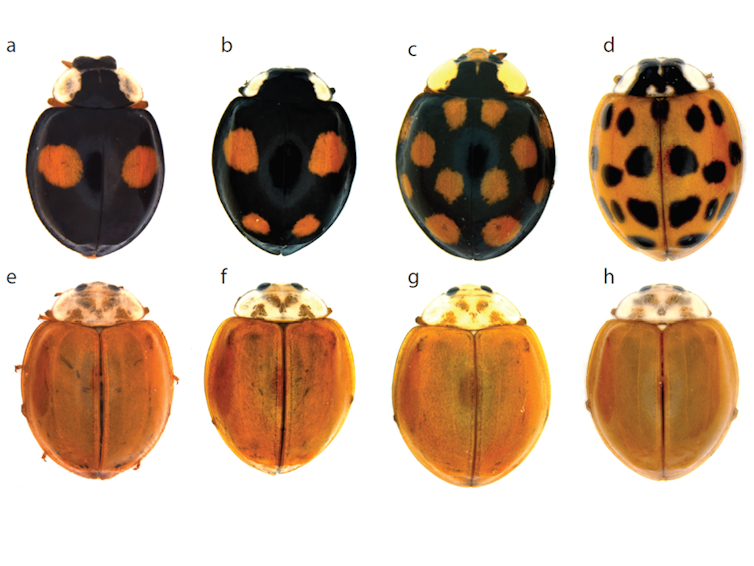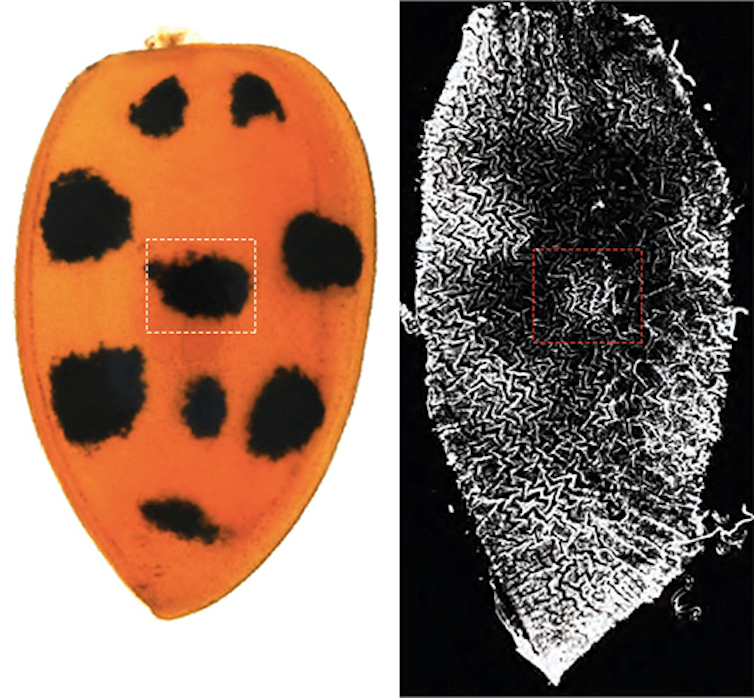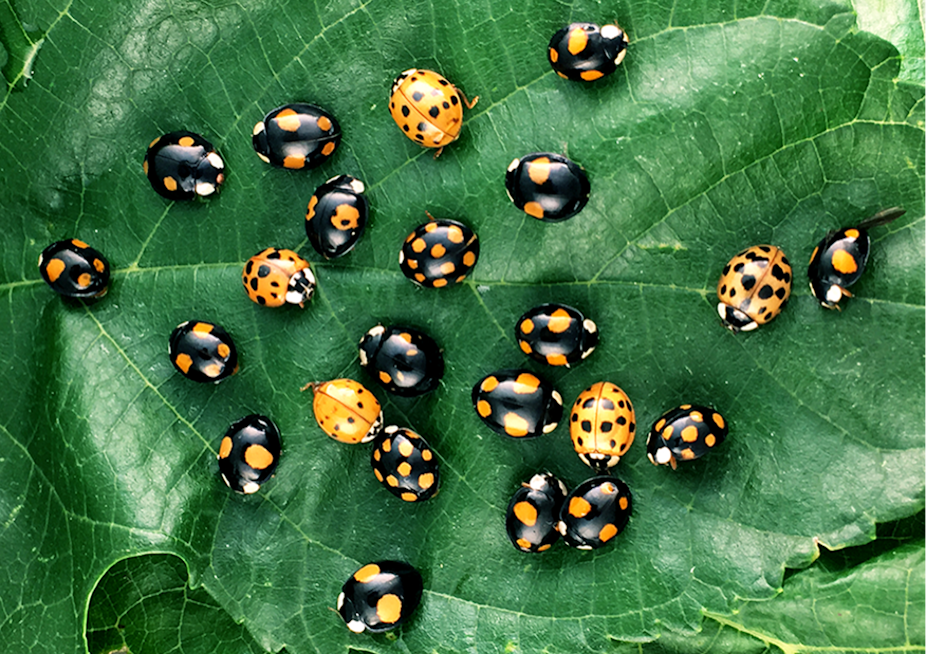What is the difference between black ladybugs with red spots and red ladybugs with black spots? Children – like adults – have once asked themselves this question. So do scientists. Since the 1920s, there has been a growing body of work on the common presence of distinct coloured patterns in insects within the same species. Leading figures in evolutionary biology, such as geneticist Theodosius Dobzhansky or ecologist Michael Majerus, have taken an interest in it.
One of the most famous cases of black pigmentation polymorphism was described in the 19th century in a butterfly, the peppered moth, with a darkened whole body. It has been called industrial melanism because the mutation that made the insect black was concomitant with the industrial revolution in England. A soot-coloured butterfly has a better chance of surviving on a soot-polluted birch.
However, in most insect species affected by melanism, darkening appears only on certain parts of the insect body, forming discontinuous and complex black patterns. This is the case with the harlequin ladybug, Harmonia axyridis, also known as the Asian ladybug. This insect is a champion of polymorphic melanic patterns with more than 200 colour pattern forms described in natural populations around the world. These shapes correspond essentially to variations in black areas on a red background on the elytra, the hardened forewings that cover the hindwings.
The colouring gene identified
The genetic mechanisms by which these melanic patterns are created and maintained in ladybug populations remain largely unknown. It has been known since the 1950s that the different colour forms result from genetic variations located in a single region of the genome, which had not previously been characterized. Our research teams join forces, putting together their expertise in population genomics and development biology, to address this problem. And our efforts paid off: we have identified the genomic origin of the different coloration patterns in harlequin ladybugs. In particular, we have identified the gene that encodes all the instructions necessary to draw the different motifs that decorate the forewings of the harlequin ladybugs. These results were published in August 2018 in the journal Current Biology.
First, we sequenced the complete genome of the harlequin ladybug. Then, to identify the region of the genome associated with colour variation, we compared the genome sequences of many harlequin ladybugs of different colour forms originating from several natural populations around the world. This analysis pointed to a specific region of the genome, which included two neighbouring genes. The successive inactivation of each of these two candidate genes identified the gene pannier as the one responsible for the formation of black patterns on the elytra.

The gene pannier was first discovered in fruit fly in the 1980s. In general, the names of genes refer, often with a hint of humour, to the physical malformations visible when this gene is mutated. For the gene pannier, it is the shape of the mutant embryo similar to a pannier that inspired its name to the geneticists who discovered it. Surprisingly, in no other insect did the gene pannier appear to be linked to the production of colour patterns. Subsequently, by revealing the location of the protein produced by this gene, we have shown that pannier is activated (or expressed) during elytra formation.

More precisely, the gene pannier is active in different populations of elytra cells that prefigure exactly where the black pigmentation will appear in adults. Pannier then activates other genes that collectively ensure the production of black pigment by these cells and thus the formation of the black spots (in “red” ladybugs) or the black background (in “black” ladybugs). The expression of the gene pannier is itself controlled by regulatory DNA sequences located around the gene. It is these sequences, which are very different in their molecular composition, that define variants of the gene pannier associated with the different colour forms. The frequencies of these variants fluctuate among populations, creating very colourful compositions within the natural populations of the harlequin ladybug throughout the world.
In summary, the different colour patterns in the harlequin ladybug find their genetic origin in variations of the spatial activation of a single gene that orchestrates the establishment of different melanisation patterns of elytra. Generally speaking, these results illustrate how variations in a single gene (genotypes) can, in some cases, generate an impressive diversity of phenotypes.
Beyond the colours
It has long been suspected that the colouring of a ladybug, and thus variations in the gene pannier, affect other traits involved in the survival and reproduction of this insect. Thus, the distribution of the different coloration forms within populations could reflect an adaptive response to local constraints (for example, climatic constraints). In this context, an interesting remark can be made, linking the colour to the invasive character of the harlequin ladybug, which from its native area in Asia, recently colonised the four continents (North America, South America, Europe, and Africa).
Surprisingly, the diversity of colour forms of H. axyridis is restricted on invaded continents. In most colonised areas (except in Europe), only the non-melanic form (red elytra with about 20 black spots) is present. To date, it has not been possible to determine whether the quasi-fixation of a single colour form in the invaded area is due to historical or demographic contingencies (simple random effects), or to a natural selection process favouring the non-melanic form during the invasion. Our findings on the regions of the genome responsible for colour variations may allow us to decide between these two hypotheses.


